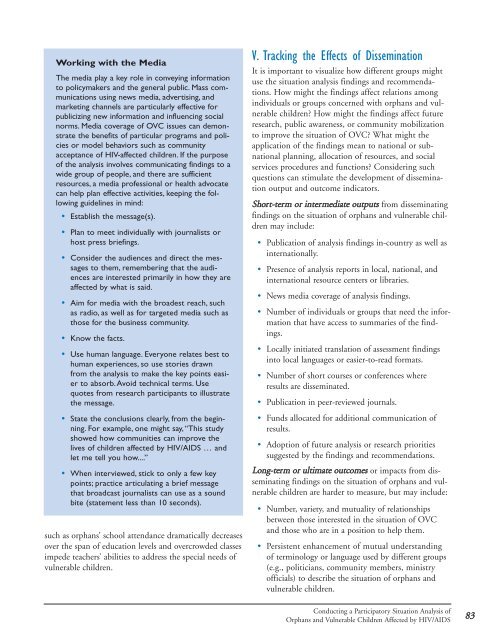Conducting a Participatory Situation Analysis of.pdf - Global HIV ...
Conducting a Participatory Situation Analysis of.pdf - Global HIV ...
Conducting a Participatory Situation Analysis of.pdf - Global HIV ...
You also want an ePaper? Increase the reach of your titles
YUMPU automatically turns print PDFs into web optimized ePapers that Google loves.
Working with the Media<br />
The media play a key role in conveying information<br />
to policymakers and the general public. Mass communications<br />
using news media, advertising, and<br />
marketing channels are particularly effective for<br />
publicizing new information and influencing social<br />
norms. Media coverage <strong>of</strong> OVC issues can demonstrate<br />
the benefits <strong>of</strong> particular programs and policies<br />
or model behaviors such as community<br />
acceptance <strong>of</strong> <strong>HIV</strong>-affected children. If the purpose<br />
<strong>of</strong> the analysis involves communicating findings to a<br />
wide group <strong>of</strong> people, and there are sufficient<br />
resources, a media pr<strong>of</strong>essional or health advocate<br />
can help plan effective activities, keeping the following<br />
guidelines in mind:<br />
• Establish the message(s).<br />
• Plan to meet individually with journalists or<br />
host press briefings.<br />
• Consider the audiences and direct the messages<br />
to them, remembering that the audiences<br />
are interested primarily in how they are<br />
affected by what is said.<br />
• Aim for media with the broadest reach, such<br />
as radio, as well as for targeted media such as<br />
those for the business community.<br />
• Know the facts.<br />
• Use human language. Everyone relates best to<br />
human experiences, so use stories drawn<br />
from the analysis to make the key points easier<br />
to absorb.Avoid technical terms. Use<br />
quotes from research participants to illustrate<br />
the message.<br />
• State the conclusions clearly, from the beginning.<br />
For example, one might say,“This study<br />
showed how communities can improve the<br />
lives <strong>of</strong> children affected by <strong>HIV</strong>/AIDS … and<br />
let me tell you how....”<br />
• When interviewed, stick to only a few key<br />
points; practice articulating a brief message<br />
that broadcast journalists can use as a sound<br />
bite (statement less than 10 seconds).<br />
such as orphans’ school attendance dramatically decreases<br />
over the span <strong>of</strong> education levels and overcrowded classes<br />
impede teachers’ abilities to address the special needs <strong>of</strong><br />
vulnerable children.<br />
V. Tracking the Effects <strong>of</strong> Dissemination<br />
It is important to visualize how different groups might<br />
use the situation analysis findings and recommendations.<br />
How might the findings affect relations among<br />
individuals or groups concerned with orphans and vulnerable<br />
children? How might the findings affect future<br />
research, public awareness, or community mobilization<br />
to improve the situation <strong>of</strong> OVC? What might the<br />
application <strong>of</strong> the findings mean to national or subnational<br />
planning, allocation <strong>of</strong> resources, and social<br />
services procedures and functions? Considering such<br />
questions can stimulate the development <strong>of</strong> dissemination<br />
output and outcome indicators.<br />
Short-term or intermediate outputs from disseminating<br />
findings on the situation <strong>of</strong> orphans and vulnerable children<br />
may include:<br />
• Publication <strong>of</strong> analysis findings in-country as well as<br />
internationally.<br />
• Presence <strong>of</strong> analysis reports in local, national, and<br />
international resource centers or libraries.<br />
• News media coverage <strong>of</strong> analysis findings.<br />
• Number <strong>of</strong> individuals or groups that need the information<br />
that have access to summaries <strong>of</strong> the findings.<br />
• Locally initiated translation <strong>of</strong> assessment findings<br />
into local languages or easier-to-read formats.<br />
• Number <strong>of</strong> short courses or conferences where<br />
results are disseminated.<br />
• Publication in peer-reviewed journals.<br />
• Funds allocated for additional communication <strong>of</strong><br />
results.<br />
• Adoption <strong>of</strong> future analysis or research priorities<br />
suggested by the findings and recommendations.<br />
Long-term or ultimate outcomes or impacts from disseminating<br />
findings on the situation <strong>of</strong> orphans and vulnerable<br />
children are harder to measure, but may include:<br />
• Number, variety, and mutuality <strong>of</strong> relationships<br />
between those interested in the situation <strong>of</strong> OVC<br />
and those who are in a position to help them.<br />
• Persistent enhancement <strong>of</strong> mutual understanding<br />
<strong>of</strong> terminology or language used by different groups<br />
(e.g., politicians, community members, ministry<br />
<strong>of</strong>ficials) to describe the situation <strong>of</strong> orphans and<br />
vulnerable children.<br />
<strong>Conducting</strong> a <strong>Participatory</strong> <strong>Situation</strong> <strong>Analysis</strong> <strong>of</strong><br />
Orphans and Vulnerable Children Affected by <strong>HIV</strong>/AIDS<br />
83















